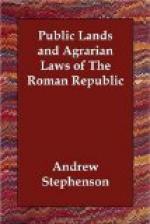The Roman territory was confined for many ages to a surface of very limited extent, which properly bore the name of Ager Romanus. This name with signification slightly changed appeared to be still in use in the time of the empire, and even at the present day a portion of the Roman territory which very nearly corresponds to the ancient territory of the imperial period is called Agro Romano.[7] That which was properly called Ager Romanus at first only occupied the surface of a slightly expanded arc whose chord was the river Tiber.[8] Primitive Rome did not extend beyond the Tiber into Etruria, and toward Latium her possessions did not extend beyond the limits of some five or six miles reckoning from the Palatine. Toward the east the towns of Antemnae, Fidenae, Caenina, Collatia and Gabia lay in the immediate neighborhood, thus limiting the extension of the city in that direction within a radius of five or six miles;[9] and northward the Anio[10] formed the limit. To the southwest as you approach Lavinium, the sixth milestone marked the boundary of Rome. Thus with the possible exception of a small strip of land extending upon either bank of the Tiber to its mouth, and embracing the old site[11] of Ostia, have we marked out all of ancient Rome. Strabo[12] says it could be gone round in a single day. And according to this same author it was within these limits that the annual auspices[13] could be taken.
Both city and land increased with time. Property seemed to have been added and lost successively during the reign of the kings.[14] The last increase of the Ager Romanus was due to the labors of Servius Tullius, and it was in the reign of this king that it reached its greatest limit. Dionysius[15] says: “As soon as he (Servius) was invested with the government, he divided the public lands among such of the Romans as having no lands of their own, cultivated those of others.... He added two hills to the city, that called the Viminal and the Esquiline hill, each of which forms a considerable city; these he divided among such Romans as had no houses, to the intent that they might build them.... This king was the last who enlarged the circumference of the city by the addition of these two hills to the other five, having first consulted the auspices as the law decided, and performed the other religious rites. Further than this the city has not since then been extended.” Without doubt these possessions received great additions in later times,[16] but they were not incorporated in the Ager Romanus as the preceding had been. The subjugated territories kept their ancient names while their lands were made the object of distributions to the people, of public sales to the citizens who also extended their possessions outside of Roman[17] territory, or else the new conquests were abandoned to municipia, given up to colonies, or became a part of that which was called Ager Publicus. In fine, it was a fundamental principle of the public law of Rome that the lands and the persons of the people conquered belonged to the conqueror, the Roman people, who either in person or by their delegates disposed of them as it seemed best. Among the ancients war always decided concerning both liberty and property.




